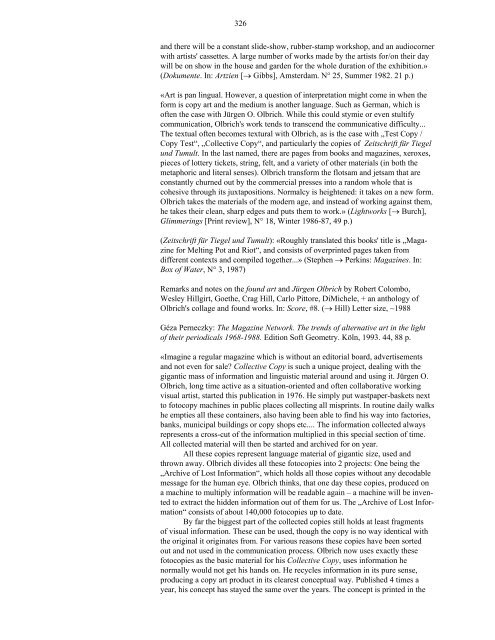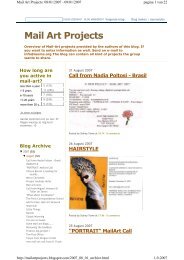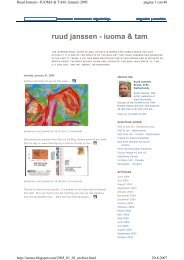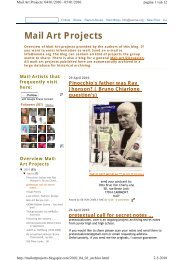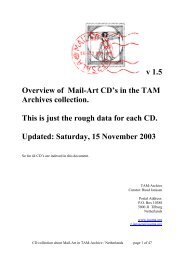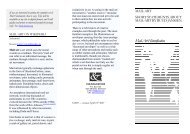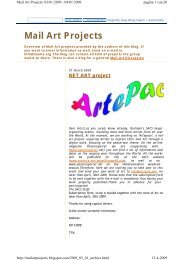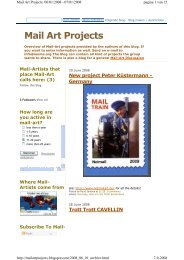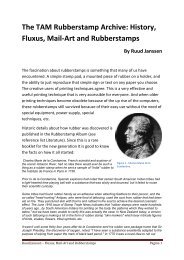Network Atlas by Geza Perneczky - Ruud Janssen
Network Atlas by Geza Perneczky - Ruud Janssen
Network Atlas by Geza Perneczky - Ruud Janssen
Create successful ePaper yourself
Turn your PDF publications into a flip-book with our unique Google optimized e-Paper software.
326and there will be a constant slide-show, rubber-stamp workshop, and an audiocornerwith artists' cassettes. A large number of works made <strong>by</strong> the artists for/on their daywill be on show in the house and garden for the whole duration of the exhibition.»(Dokumente. In: Artzien [→ Gibbs], Amsterdam. N° 25, Summer 1982. 21 p.)«Art is pan lingual. However, a question of interpretation might come in when theform is copy art and the medium is another language. Such as German, which isoften the case with Jürgen O. Olbrich. While this could stymie or even stultifycommunication, Olbrich's work tends to transcend the communicative difficulty...The textual often becomes textural with Olbrich, as is the case with „Test Copy /Copy Test“, „Collective Copy“, and particularly the copies of Zeitschrift für Tiegelund Tumult. In the last named, there are pages from books and magazines, xeroxes,pieces of lottery tickets, string, felt, and a variety of other materials (in both themetaphoric and literal senses). Olbrich transform the flotsam and jetsam that areconstantly churned out <strong>by</strong> the commercial presses into a random whole that iscohesive through its juxtapositions. Normalcy is heightened: it takes on a new form.Olbrich takes the materials of the modern age, and instead of working against them,he takes their clean, sharp edges and puts them to work.» (Lightworks [→ Burch],Glimmerings [Print review], N° 18, Winter 1986-87, 49 p.)(Zeitschrift für Tiegel und Tumult): «Roughly translated this books' title is „Magazinefor Melting Pot and Riot“, and consists of overprinted pages taken fromdifferent contexts and compiled together...» (Stephen → Perkins: Magazines. In:Box of Water, N° 3, 1987)Remarks and notes on the found art and Jürgen Olbrich <strong>by</strong> Robert Colombo,Wesley Hillgirt, Goethe, Crag Hill, Carlo Pittore, DiMichele, + an anthology ofOlbrich's collage and found works. In: Score, #8. (→ Hill) Letter size, ~1988Géza <strong>Perneczky</strong>: The Magazine <strong>Network</strong>. The trends of alternative art in the lightof their periodicals 1968-1988. Edition Soft Geometry. Köln, 1993. 44, 88 p.«Imagine a regular magazine which is without an editorial board, advertisementsand not even for sale? Collective Copy is such a unique project, dealing with thegigantic mass of information and linguistic material around and using it. Jürgen O.Olbrich, long time active as a situation-oriented and often collaborative workingvisual artist, started this publication in 1976. He simply put wastpaper-baskets nextto fotocopy machines in public places collecting all misprints. In routine daily walkshe empties all these containers, also having been able to find his way into factories,banks, municipal buildings or copy shops etc.... The information collected alwaysrepresents a cross-cut of the information multiplied in this special section of time.All collected material will then be started and archived for on year.All these copies represent language material of gigantic size, used andthrown away. Olbrich divides all these fotocopies into 2 projects: One being the„Archive of Lost Information“, which holds all those copies without any decodablemessage for the human eye. Olbrich thinks, that one day these copies, produced ona machine to multiply information will be readable again – a machine will be inventedto extract the hidden information out of them for us. The „Archive of Lost Information“consists of about 140,000 fotocopies up to date.By far the biggest part of the collected copies still holds at least fragmentsof visual information. These can be used, though the copy is no way identical withthe original it originates from. For various reasons these copies have been sortedout and not used in the communication process. Olbrich now uses exactly thesefotocopies as the basic material for his Collective Copy, uses information henormally would not get his hands on. He recycles information in its pure sense,producing a copy art product in its clearest conceptual way. Published 4 times ayear, his concept has stayed the same over the years. The concept is printed in the


